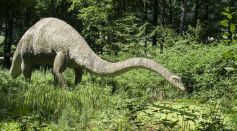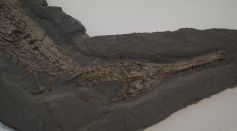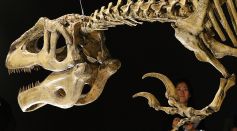Tags: South America
Brazil's Enigmatic Dogxim: First-of-Its-Kind Canine Hybrid Between a Fox and a Dog Found in the Streets of Vacaria

Wild and Feral Pigs Ravage Protected Natural Areas Across South America, Threaten Biodiversity Hotspots in the Region

South America Sees Around 2,000 Dead Penguins Washing Up on Shore With Empty Stomachs

Ancient Sloth Bones Reveal Early Human Presence in South America: A Key Discovery in Rewriting History
Highest UV Index Ever: South America Set the Blazing World Record

Huge Cave Networks in South America Might be Burrows Created by Ancient Giants, According to Study

Dinosaurs Crossed Continents Through Nearly 100-million-year-old Land Bridge in Antarctica, Study Finds
Sabertooth That Roamed South America 3 Million Years Ago Had Large Canine, Pushing Its Eyes to the Sides of the Head [Study]
350-Pound Arapaima Fish Caught in South America [Watch]

Ancient Human Remains from Colonial Era Unearthed in Peru, With Deformed Skulls and Likely Died from Syphilis

7-Million-Year-Old Fossil Found in Peru Shed Light on the Marine Origins of Modern Crocodiles

Ancient DNA from Uruguay Gives a Glimpse of South America's 'Lost' Indigenous People

33-Foot Dinosaur Bones Unearthed in Argentina Could Be the Biggest Megaraptor Ever Found

Fluffy Herding Dogs in South America Found as Closest Relative of UK Ancient Sheepdog Breed from 200 Years Ago

Unexpected Journey of Two Southern Right Whales Reached 10,000 Kilometers Across the Atlantic

Social Spiders Hunt in Large Groups, Coordinately Ambush Prey Using Web Vibrations
39-Million-Years-Ago, Volcanic Eruption Left a Petrified Forest That Now Reveals South America's Primeval Past

Here's Why South America Filled With Mammals From North America
Cross-Border Science Team to Preserve Lake Titicaca Giant Frogs
Genetic Studies on Ancient Caribbean Inhabitants Reveal a Mosaic of History Contrary to Traditional Research
Most Popular

Ancient Hotspot Found to Have Created Great Lakes 300 Million Years Ago

Mysterious Structures Discovered Beneath the Pacific Ocean, Puzzle Scientists

Health Benefits of Drinking Hot Chocolate

Largest Known Volcanic Aquifer Discovered Beneath Oregon's Cascades




